On climbing the magnificent curved staircase to the third floor of Waddesdon Manor, visitors will quickly spot that they are entering an opulent and rarefied environment. Low lighting brings out the shimmering threads of the embroideries hung on the walls. An imposing ironwork gate signals the entrance to a vault whose three walls are lined with shelves of treasures and whose barrel roof is covered in gold leaf. This is the new treasury, a permanent installation of some exceptional pieces selected from the Waddesdon and family collections, as well as pieces acquired specifically for the space. In the words of house manager Pippa Shirley, it reveals the Rothschild vision in microcosm, a sort of ‘Waddesdon in the womb’.
The new treasury belongs to and perpetuates a very Rothschild type of display. Members of the family popularised the neo-Renaissance Kunstkammer in the nineteenth century, self-consciously reviving a type of early modern collecting found in the Green Vault in Dresden or the Schatzkammer of the Wittelsbachs in the Munich Residenz. Rothschild variations on this European collecting tradition can still be visited in the Hôtel Berryer in Paris (where fragments of Salomon de Rothschild’s cabinet of curiosités have been reassembled, in accord with the donation of his widow Adèle) and of course in the gleaming vitrines of the Waddesdon Bequest at the British Museum, created through the generosity of Ferdinand de Rothschild in 1898. The new treasury complements the evidence provided by the Smoking Room of the English Rothschilds’ deep interest in the splendours of Renaissance craftsmanship and design.
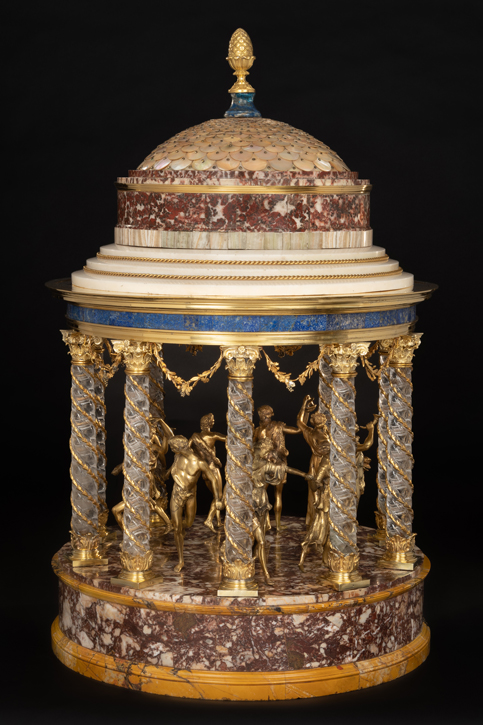
Table centrepiece (18th century), Luigi Valadier. Photo: Waddesdon Image Library/Mike Fear
The display also spotlights members of the family whose presence has sometimes been rather obscured in the story of Waddesdon, including Alice de Rothschild, Ferdinand’s formidable sister, her refined French cousin, Edmond de Rothschild, and his heirs, and Dorothy de Rothschild, who oversaw the transfer of the house to the National Trust in 1957. Numerous intimate objects cast light on their aesthetic choices and the web of family relationships which spanned the channel.The first cabinet contains a mourning brooch from the funeral of Nathan Meyer de Rothschild in 1838, the founder of the dynasty, as well as the mahogany case containing ancient coins which belonged to his son, baron James Mayer (Edmond’s father). It also displays a bracelet given by Queen Victoria to Alice, following her visit to Grasse, as well as an amethyst pendant given to her by Queen Alexandra, not to mention an intriguing little box to hold the citrus fruit known as etrog, used in the Jewish festival of Sukkot. The extraordinary, geometric emerald necklace made by Parisian jeweller Bucheron passed from Edmond’s wife, Adelheid, to Dorothy; the dazzling stones themselves were probably purchased at Christie’s at the sale of Empress Eugénie’s jewels in 1872. The darker side of family history is also present, with various objects retaining the inventory numbers assigned in 1940 when Edmond’s collections were confiscated and re-appropriated by the Nazis.
The artistry and ingenuity of the 323 objects on display is little short of astonishing. The sensitive lighting provided by designer Charles Marsden-Smedley brings out the myriad hues and iridescence of the artworks, grouped according to their material properties. Reminiscent of the recent exhibition of the Campana collection at the Louvre, the result is a lesson in the capacities of different kinds of substance: the smooth, almost liquid, jade of a horse from 18th-century China; the gleam of hardstones worked and mounted by Fabergé; the sharp, bright colours of lapis lazuli vases and Limoges enamels; the lustre of Bohemian glassware; the warm glow of an amber casket made in Königsberg, specially lit from inside. In this sensuous arrangement of colours and tones, the viewer feels both curiosity and wonder, marvelling at the skill with which very different and often intractable materials have been shaped and polished and combined. The desire to touch is irresistible, thanks to the displays which encourage a kind of intimate and attentive looking.
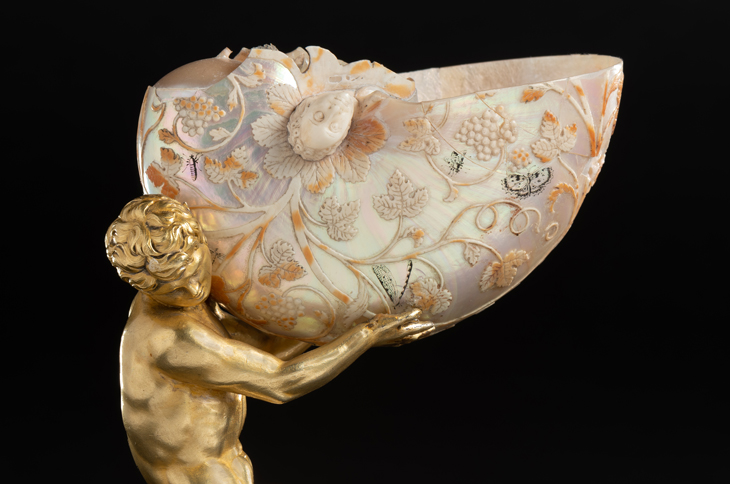
Triton with a nautilus shell (shell: c. 1700; triton and base: c. 1810–30), Cornelius Bellekin. Photo: Waddesdon Image Library/Mike Fear
Once the initial, rather heady, visual pleasure has passed, visitors in search of additional information can make excellent use of the Smartify app on their phones. Dispensing with captions, the curators’ texts are instead available as a booklet at the entrance or in an elegant online format which offers an expert description of each object and its provenance. Here, the Rothschild family passion for history can be fully appreciated: the magnificent Triton with a nautilus shell was originally owned by William Beckford; one gold snuffbox mounted with porcelain plaques represents Mimi and Babe, the two dogs owned by the marquise de Pompadour (Alice was mad for dogs, especially pugs); to judge from the inventory drawn up by the French revolutionaries in 1795, a small vase from the cabinet intérieur at Versailles was probably worked by royal hands, since Louis XV and Louis XVI, as well as the former’s daughters and the latter’s brothers, were all trained by artisans to work ivory on the lathe. The informative texts also identify the moments when the Rothschilds were occasionally duped by the forgers’ art, including the composite Renaissance jewels fashioned by Alfred André. The Smartify technology seems perfectly suited to enable visitors to explore the many fascinating histories of these objects at their own pace.
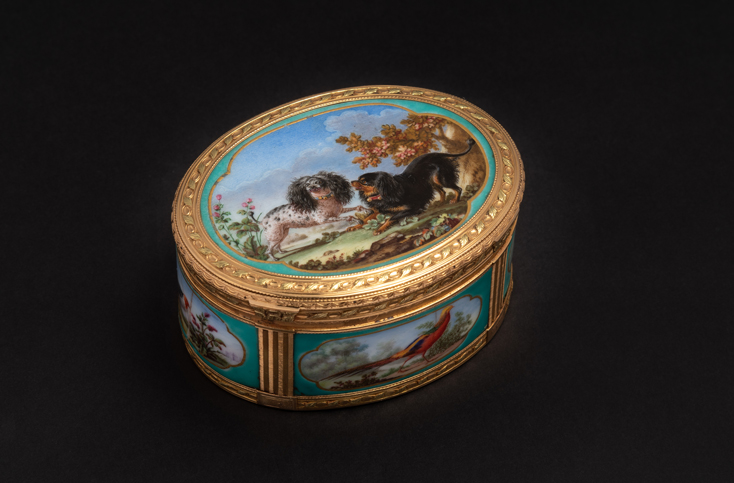
Snuff box (1772–73), Louis Roucel. Photo: Waddesdon Image Library/Mike Fear
The range of periods and civilisations captured in just three hundred objects is remarkable, with a chronology running from 945 BC to 1934. Edmond de Rothschild generously supported several French archaeological expeditions, and the displays contain pieces from the celebrated digs at Boscoreale (a spoon a held back from the donation to the Louvre) and ancient jewellery from Palestine, as well as his passion for the arts of Egypt, the Far East and of Islam (including Mughal objects from the orientalist smoking room of his Parisian townhouse). The Waddesdon team, and especially curators Pippa Shirley and Mia Jackson, are to be warmly congratulated for bringing out the intellectual coherence and aesthetic harmony of an eclectic selection of artefacts, whose common thread lies in their rarity and superb workmanship, and their appeal to successive generations of Rothschild collecting personalities.
‘A Rothschild Treasury’ is now open at Waddesdon Manor, Buckinghamshire
Unlimited access from just $16 every 3 months
Subscribe to get unlimited and exclusive access to the top art stories, interviews and exhibition reviews.

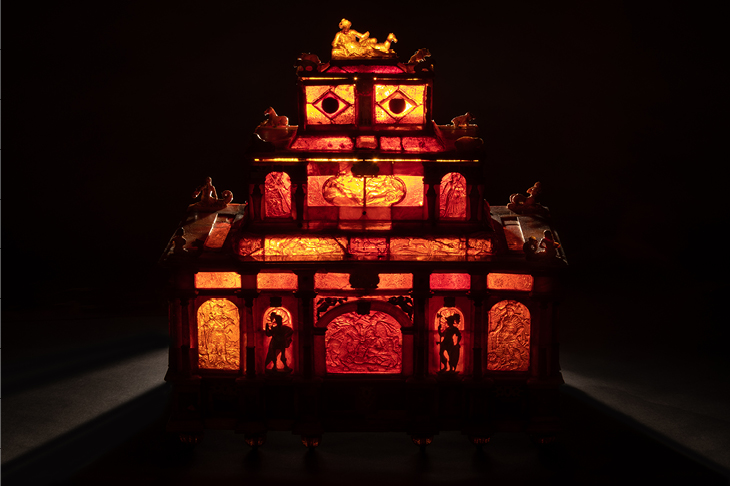
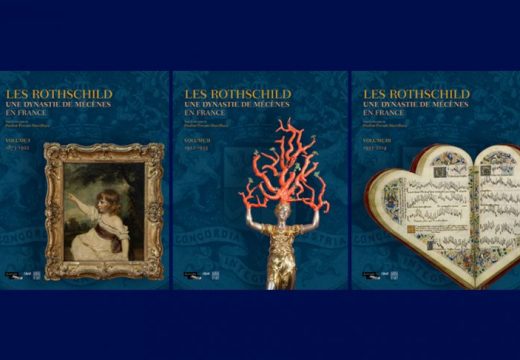
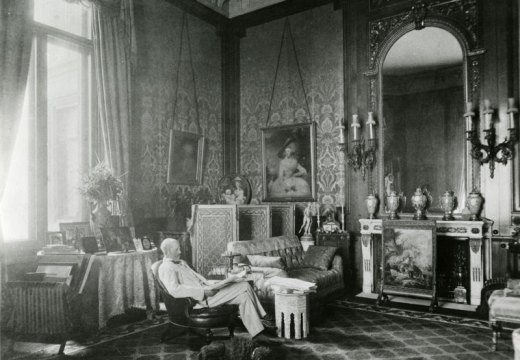
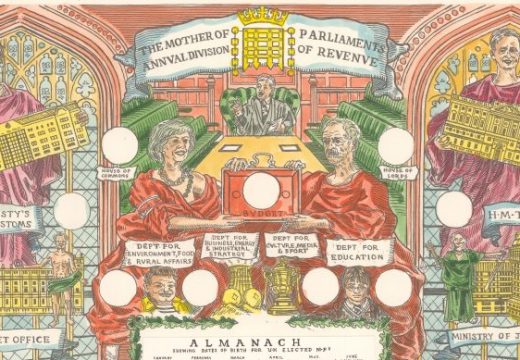









![Masterpiece [Re]discovery 2022. Photo: Ben Fisher Photography, courtesy of Masterpiece London](http://www.apollo-magazine.com/wp-content/uploads/2022/07/MPL2022_4263.jpg)
Has the Fitzwilliam lost the hang of things?